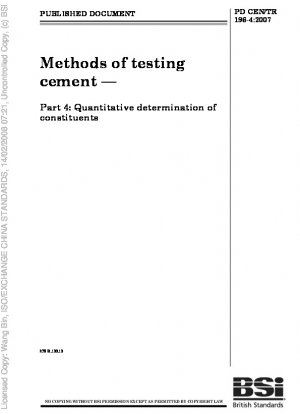BS PD CEN/TR 196-4:2007
Methods of testing cement — Part 4: Quantitative determination of constituents
- Standard No.
- BS PD CEN/TR 196-4:2007
- Release Date
- 2007
- Published By
- British Standards Institution (BSI)
- Latest
- BS PD CEN/TR 196-4:2007
- Scope
- This European Technical Report describes procedures for determining the contents of most of the constituents of the cements that fall within the scope of EN 197-1. In principle, the method described in Clause 6 applies to all cements, whatever the number and nature of their constituents, but in practice is limited to the cements identified in Table 1. The method in clause 6 should be considered to be the method of choice and is based on a sequential selective dissolution of the cement’s constituents, generally of an unknown number, where they are not available separately for analysis at the same time as the cement. The method of choice enables the quantitative determination (by mass) of: Portland cement clinker, blastfurnace slag, siliceous fly ash, natural pozzolans, limestone, silica fume and set regulators in cements of the types identified in Table 1. Table 1 is derived from Table 1 of EN 197-1. The method of choice has limitations, as indicated earlier, and cannot be considered to be a means by which clinker content can simply be determined in isolation from any other constituent. Clinker content is determined ‘by difference’ and other constituents contain, in part, mineral phases similar to those present in clinker and can cause interferences that lead to difficulties in interpretation of the results. Where apparently anomalous results are obtained, it is recommended that further investigations are undertaken in accordance with the procedure given in Section 6.2.5.4. Any other method with the same objectives, and intended for use where the constituents are unavailable for separate analysis, can be considered to be an alternative to the method of choice when it is shown that, with appropriate statistical validity, it gives equivalent results. In individual cases, where the laboratory has been formally advised that: the cement contains only two constituents, the method is greatly simplified because it is sufficient to determine the set regulator content (R) in order to be able to calculate the clinker content by difference; the cement contains only three constituents, i.e. a set regulator, clinker and one of the following three: slag, pozzolana or siliceous fIy ash. Some of the methods in clause 7 are variations on the method of choice whereas others are based on physical separation of constituents and different analytical principles. NOTE 2 This European Technical Report adopts the following use of terms for major constituents: ‘Portland cement clinker’ as defined in EN 197-1 is referred to as ‘clinker’; ‘granulated blastfurnace slag’ as defined in EN 197-1 is referred to as ‘slag’; ‘natural pozzolans’ as defined in EN 197-1 is referred to as ‘pozzolans’; ‘siliceous fly ash’ as defined in EN 197-1 is referred to as ‘fly ash’; ‘calcium sulfate’ as defined in EN 197-1 is referred to as ‘set regulator’.
BS PD CEN/TR 196-4:2007 Referenced Document
- EN 196-2 Method of testing cement - Part 2: Chemical analysis of cement*, 2013-06-01 Update
- EN 196-7 Methods of testing cement - Part 7: Methods of taking and preparing samples of cement*, 2024-04-18 Update
- EN 197-1 Cement - Part 1: Composition, specifications and conformity criteria for common cements*, 2011-09-01 Update
- ISO 3534 Statistics — Vocabulary and symbols
BS PD CEN/TR 196-4:2007 history
- 2007 BS PD CEN/TR 196-4:2007 Methods of testing cement — Part 4: Quantitative determination of constituents
